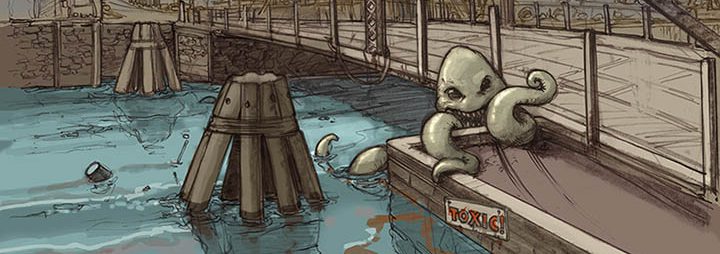When the Dutch arrived at New Amsterdam around 1630, they purchased land across the Western Edge to develop for agricultural settlement. Large areas of the Gowanus Creek formed part of the purchased land. So, if we want to trace the Gowanus Canal, it goes way back to the 1630s which they called the canal, The Gowanus Creek. It became an important daily use for the Dutch to be able to travel back and forth to Manhattan. Around the 1840s, the creek was known for their huge oyster’s sales. From 1853 to 1874, the canal became the main transport lane for the height of the Industrial Era. By 1920, the canal was the most trafficked canal in Brooklyn. Considering the amount of traffic that the Gowanus has experienced, you can say that the Gowanus Canal has become dirty as the years passed by.
Today the Gowanus Canal is not only polluted but it’s worst when the rain hits. There are 11 outfalls and sewer exits emptying into the canal. That’s approximately 400 million gallons of wastewater being dumped in the canal every year. Let alone, the rain water must be factored in as well. On rainy days, the canal has overflooded and taken over the Gowanus community streets. During hurricane Sandy in 2012, the raw sewage flowed straight to the canal. With the excessive rain from the hurricane and the overflowing sewage, you can see human waste floating in the streets. This problem keeps happening in the Gowanus community. The sewage system needs repairing and the canal is already taking in more that its suppose to. Besides the over flowing into the canal, the contamination issue keeps increasing and gets worst as time passes by.
When asking guest speaker, Joseph Alexiou, “What should the city do to clean the canal?” His answer was “If the city changes the entire sewage system in Gowanus it can help control the amount of water flowing to the canal. It will also prevent the sewage overflow and the flooding.” But then as good as that idea sounds, Joseph admitted that the city wouldn’t even consider that, due to the amount of money that will take to accomplish. Not only the money will be the issue, but the time to redesign a new sewer system. Joseph believes that it will take a few decades before the canal can be a little cleaner. He also points out that the city has been ignoring the sewage problem and that made the contamination worsen.
I can agree with Joseph when he says that the city will completely ignore the whole replacing the sewer system idea. Over the summer I worked at a city agency, Department of Design and Construction, and just being there I noticed that before the city starts working on any project, they must undergo many stages before they can even get approval. So aside from the length of all the initial process, the project might just shut down due to the amount of money that the city will have to invest in. Now maybe if the city redirects some of the water flowing in canal to another body of water, that can help solve the overflowing of the canal issue. I’ve also thought that if the city starts digging up the many layers of sediment that the canal has, maybe the contamination level decreases. It either can help or worsen the contamination. The main question that will always linger is, “When is the Gowanus Canal going to be decontaminated?” And many other questions like what is the city going to do about it? Will they continue to ignore it ?



